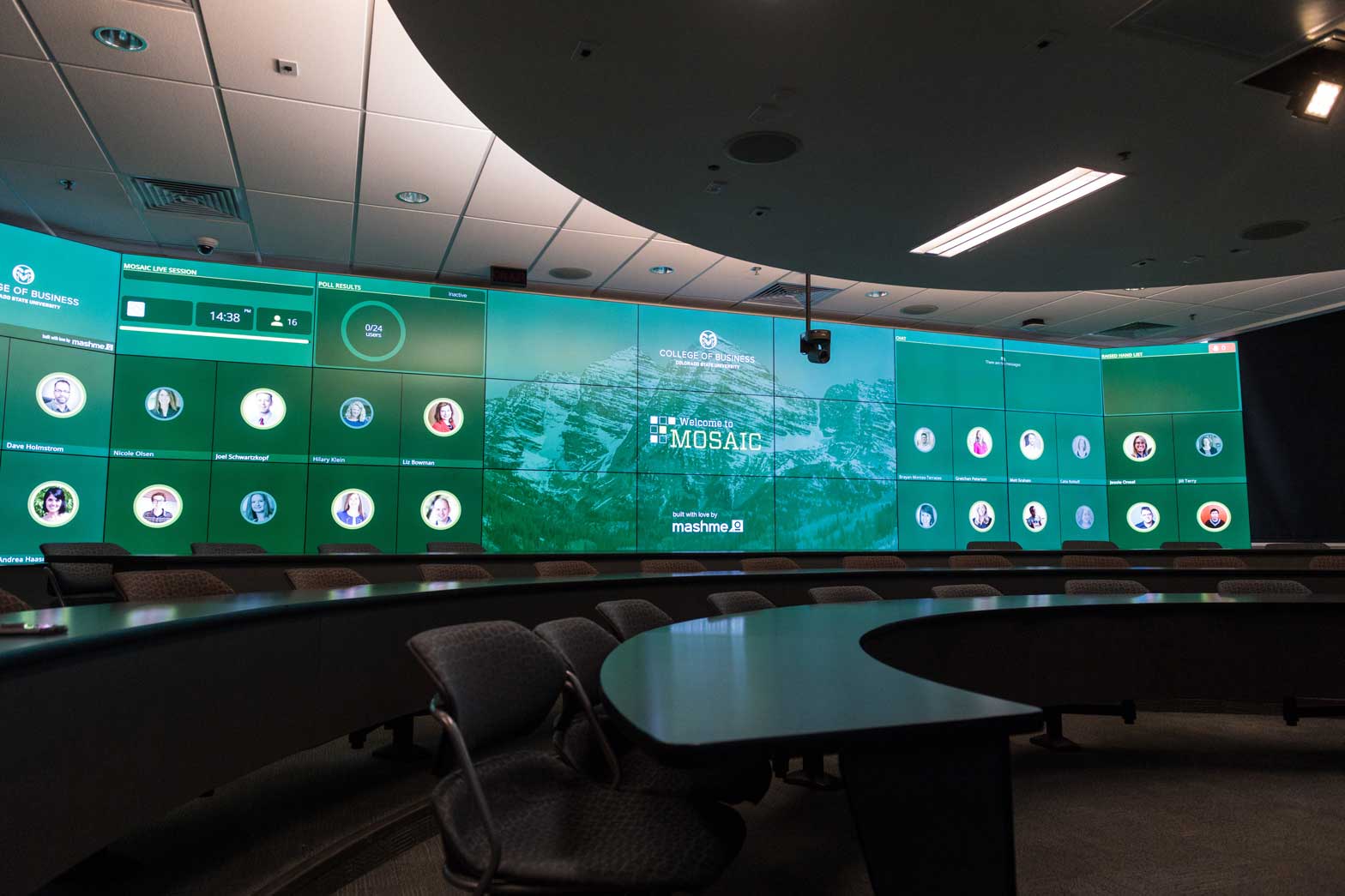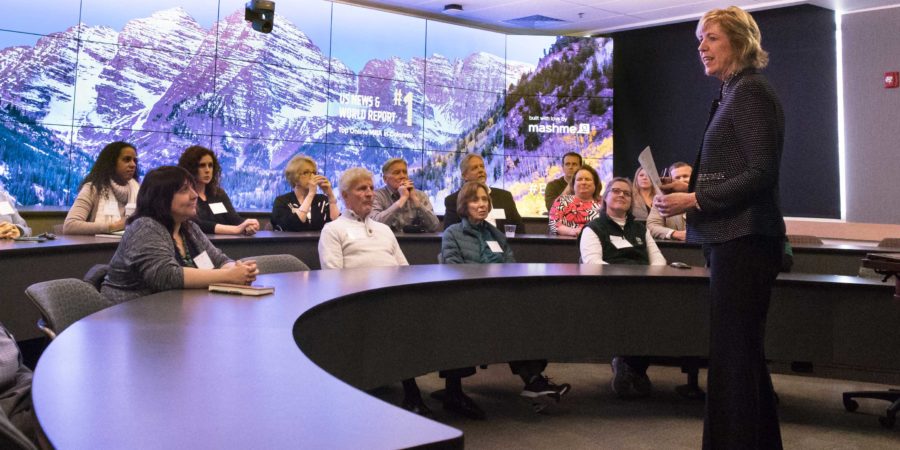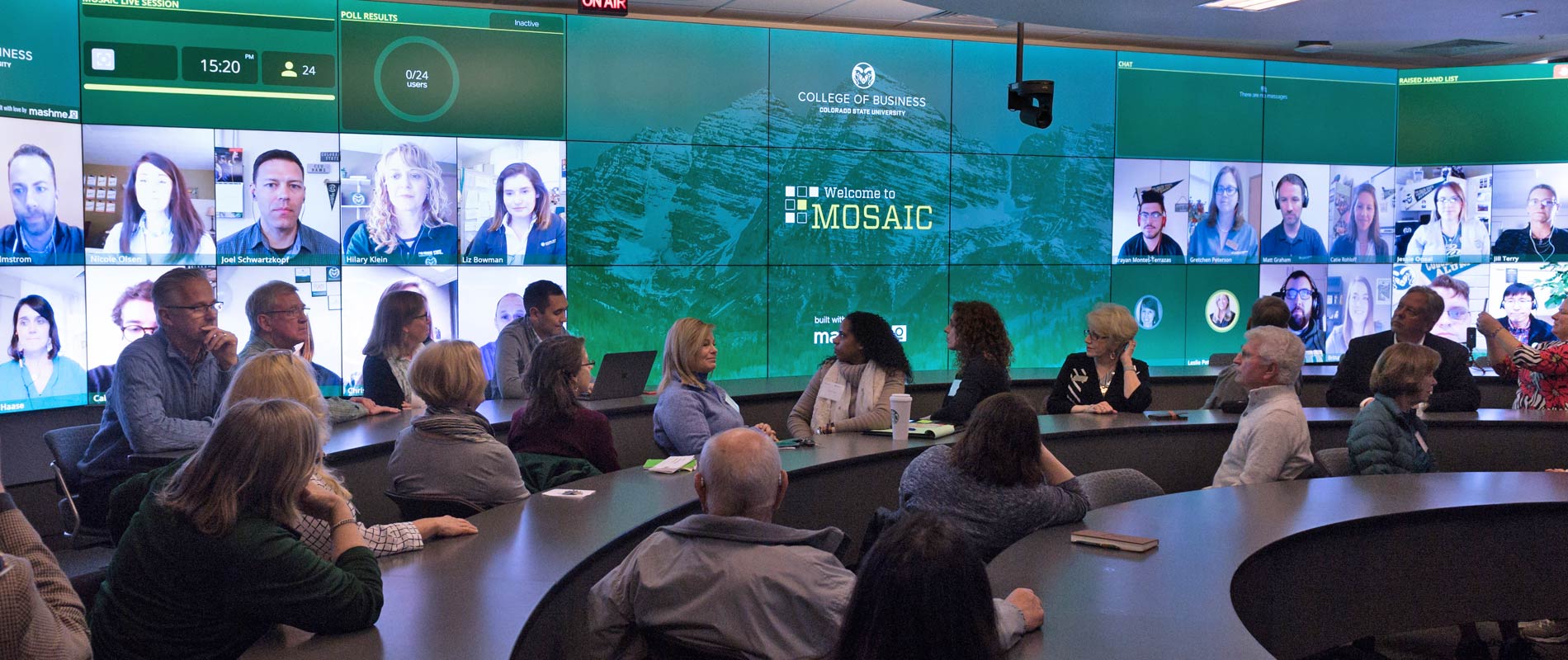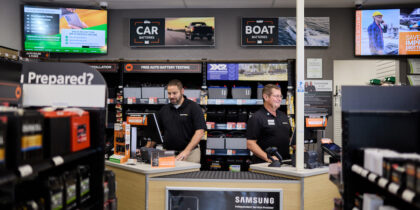
The Challenge
Colorado State University’s (CSU) College of Business has been offering distance learning for students since the 1970s, when classes were delivered on VHS tapes sent through the mail. Over the decades, the College of Business has steadily sought technology and practices that can help bring remote students together, connecting them in unique ways to the educational and classroom experience of on-campus students.
Lecture-capture video recordings, live streaming and chat functionality have contributed to bridging this gap, and students are continuing to respond positively to efforts to more seamlessly connect the online and on-campus educational experiences. However, the technological innovations required to meet this need are complex.
The Solution
CSU’s College of Business worked with software and A/V solutions providers to build and launch a unique classroom environment that enables Online MBA students to all but physically sit in the same room as on-site students. Called Mosaic, the system uses a 27-screen, 4K-ready Samsung LCD video wall, and mashme video collaboration software to have remote students’ live faces fill the back rows of a converted CSU classroom. Online students can now be involved as directly as on-site students, and faculty can see and engage every student in a lecture or working session.
“[Online students] can ask their questions and feel like they’re more part of the class.” Richie Nelson, CSU College of Business IT Director
The Results
Initial responses have already been so positive that CSU is planning a second classroom. The College of Business is running a pilot in summer 2019 and steadily surveying students and instructors on what works or needs tweaking. The College anticipates making the Mosaic classroom more broadly available in 2020 and is evaluating the potential to extend access to the wider CSU community and beyond, possibly to corporate clients.

About Colorado State University's College of Business
CSU’s College of Business is a top-ranked, Association to Advance Collegiate Schools of Business (AACSB)-accredited business school, and has been a longtime pioneer in distance learning. Its main campus is in Fort Collins, about an hour north of Denver, and just east of the Front Range of the Rocky Mountains. CSU is known as a public research university, and the state’s largest land grant university. It has over 34,000 students.
The Challenge
Same Class, Same Instructor — Different Experiences
CSU’s College of Business has offered distance learning since the 1970s with constant attention to exploring ways to match the online and in-class student experiences.
Tools that facilitate online audio and video have helped — in a produced environment that’s part classroom, part TV studio — but remote students who access the videos on-demand are only able to easily interact with their online peers and educators. A number of these online students have expressed the desire to be more actively involved in classroom collaborations, beyond standard video-calling solutions that can be difficult to implement in a live classroom environment.
The most recent iteration of a tech-driven classroom involves multiple cameras and an operator/producer capturing the entire experience of the in-class students, and delivering it to remote screens. Students can see the lecturer and what is written on digital displays, as well as shots of on-site students as they ask questions or share their thoughts.
“At graduation we always have online students who go up to the on-campus students and start having a conversation like they’ve known each other the entire time. So, we are already building this experience where our online students feel a connection to the classroom,” said Richie Nelsen, the College of Business’ director of information technology.
“But we were getting feedback from them,” Nelsen adds, “saying that they would really like to participate more and be able to share some of the insights they’ve gained from their work experiences.”
Online chat windows that relayed questions to a teaching assistant, who then asked them out loud to the classroom, were not ideal. Attempts at using livestreaming software that brought students into a virtual meeting also had mixed results.
“They can ask their questions and feel like they’re a little more a part of the class than just typing a question in,” recalls Nelsen. “But there is quite a process involved to pull a particular student’s webstream, and visualize them on a classroom screen.”
More research exposed Nelsen to mashme, a Spanish software company that powers immersive learning and collaboration environments. The company, with roots in videoconferencing, started marketing what it called the Room of the Future in 2017, and that fall, had its first signature installation at the Said Business School at England’s famed Oxford University.
Nelsen’s initial take was that the technology had immense potential for the College of Business, but was out of the school’s budget range. He met with Dave Hoblick, an account manager with A/V integrator Howard Technology Solutions, who started looking into mashme. Hoblick worked with mashme and Samsung to come up with a pricing formula and technology mix that was workable.
The Solution
Seamlessly Blended Online and On-Site Classroom
Nelsen traveled to Oxford to get the impressions and recommendations of the business school dean and students and returned with a plan, as well as a pitch for space and funds.
The College of Business bought in, and one of the existing studio classrooms was designated as the first iteration of a system dubbed Mosaic. It was a departure from Oxford and other mashme Rooms of the Future.
“We decided to install the system in the back of one of our existing classrooms, which makes it feel like an extra row of seating behind our on-campus students,” Nelsen said. “This approach really lends itself to a more natural adoption of the technology.”
Working with Howard, the College of Business put in 27 narrow-bezel 55-in. Samsung LCD displays, set up in a video wall array that is nine units wide and three rows high. The screens are driven by three Datapath video wall controllers, and fed from a mashme server.

Images Courtesy Colorado State University College of Business
Each online student has their own display window, and software that flashes their window if they have questions or comments.
The setup achieves several improvements:
- The online students are essentially populating the virtual back rows of the classroom, and the environment feels much more like a classroom than a futuristic studio.
- Students on premises can simply turn around and both see and hear a virtual classmate, just as they would when a classmate in the room is speaking behind them.
- Faculty members have a much more natural teaching environment, and can more comfortably adapt to the new setting than they would in a more intimidating studio setting.
The room also includes a flanking pair of 82-in. LCD displays at the front of the classroom that are used for running presentation materials from the podium. In the middle, behind the lecturer, is an 85-in. collaboration whiteboard.
Hoblick says 4K visuals were important both now and for future classroom applications. There were many display options, but mashme had a positive experience with Samsung’s video wall LCDs due to their reliable support and competitive pricing.
“All of those things combined made Samsung a perfect partner for CSU’s College of Business and Mosaic,” said Hoblick.
During lectures, the mashme software enables simultaneous interactions with remote students through polls, group discussions and engagement tools. Remote students log in and interact using a simple web browser. Desktop, tablet and mobile are all supported.
Existing CSU College of Business staff who were already running the existing online experience have incorporated mashme into their skill sets and processes, providing in-room support during live classroom sessions.
Images Courtesy Colorado State University College of Business
The Technology
55 inch LCD: UHF-E series
The Results
Richer Student Connections, Deeper Learning
With the Mosaic classroom installed in just two weeks, CSU’s College of Business is the first school in the U.S. to build and run a blended classroom that connects on-campus and online students in real time. Mosaic is being piloted with an accounting course that’s part of the MBA program, and the College of Business is anticipating that the first Mosaic classroom will be more broadly available in 2020.
A faculty member has developed a survey, with plans to take the pulse of participants weekly, looking for insights and ways to tweak the service.
The college is also evaluating the potential to extend access to the CSU community and beyond — potentially to corporate teams. Nelsen says a second Mosaic classroom is being considered.
“We are in the business of transforming lives, and Mosaic helps us continue that tradition,” said CSU College of Business Dean Beth Walker, when Mosaic was announced in March. “Online students can collaborate, share ideas, and move concepts forward in real time. That’s the true power of Mosaic — its ability to create connection and deepen learning for students from all walks of life to make the CSU College of Business’s top-ranked business degrees attainable no matter where they may live or work.”
CSU is the first in the United States to deploy the technology, but Hoblick expects more higher education institutions will be inspired by Mosaic. “That’s what the mashme people have been telling me — that interest will kind of steamroll here, because it’s what they’re experiencing in Europe.”









